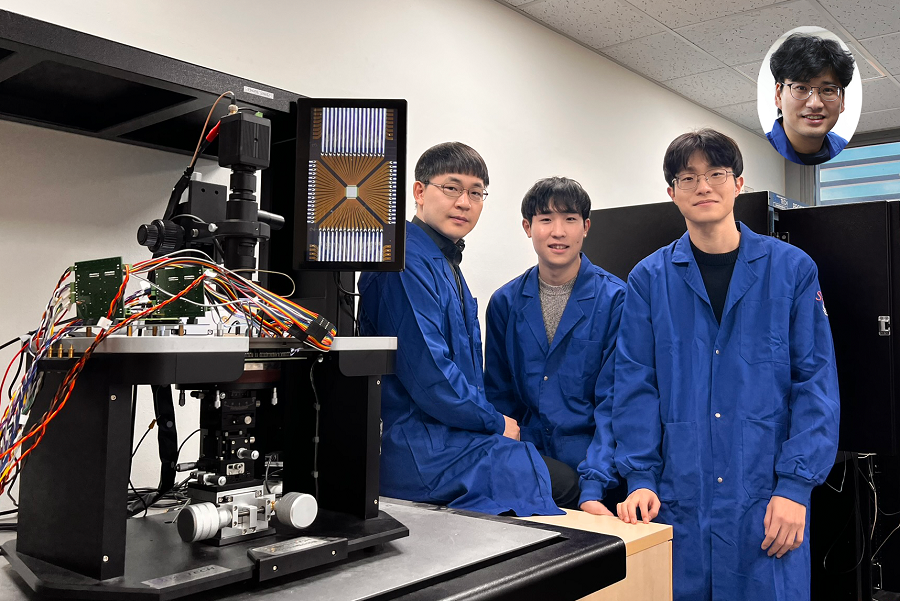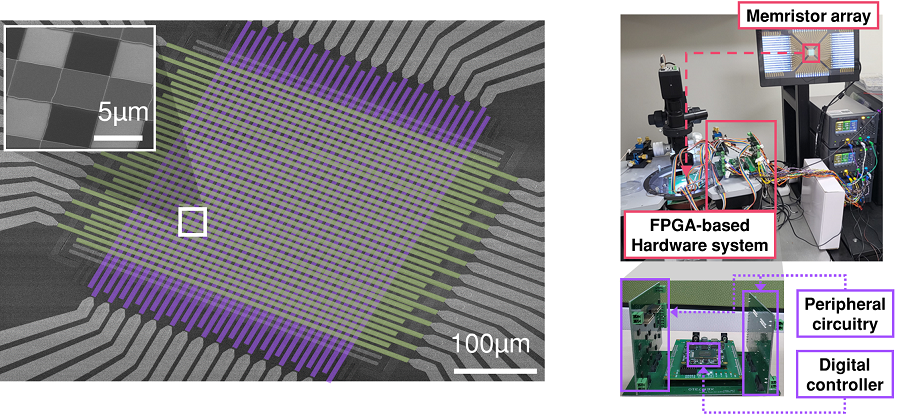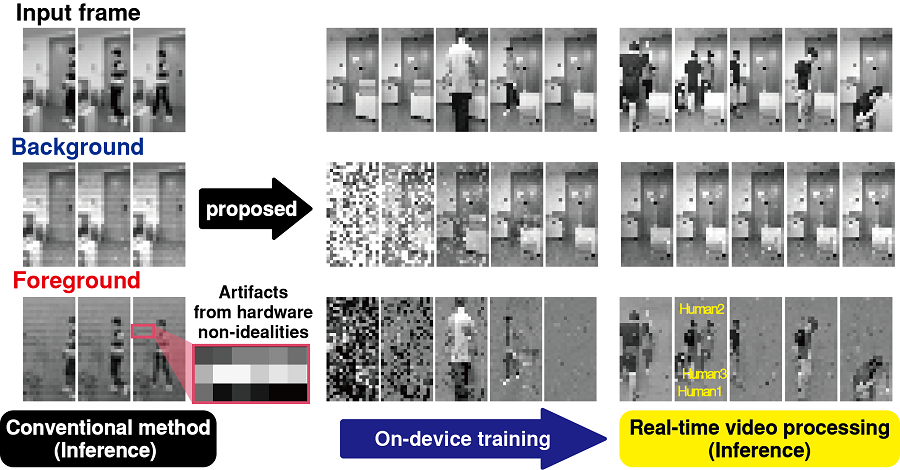Groundbreaking chip processes data like the human brain, enabling smart devices to learn and adapt in real-time without relying on cloud servers—revolutionizing AI applications from security cameras to healthcare.

The research team of the School of Electrical Engineering posed by the newly deveoped processor. (From center to the right) Professor Young-Gyu Yoon, Integrated Master's and Doctoral Program Students Seungjae Han and Hakcheon Jeong and Professor Shinhyun Choi
Existing computer systems have separate data processing and storage devices, making them inefficient for processing complex data like AI. A KAIST research team has developed a highly reliable, selector-less memristor-based integrated system similar to how our brain processes information. It is now ready for application on various devices, including smart security cameras, which can recognize suspicious activity immediately without relying on remote cloud servers, providing enhanced privacy and reduced bandwidth usage, and medical devices that can analyze health data in real-time with high accuracy.
Their work has been published in the journal Nature Electronics, achieving a peak signal-to-noise ratio (PSNR) of 30.49 dB and a structural similarity index measure (SSIM) of 0.81, comparable to ideal simulations. The system processes video streams at approximately 0.7 frames per second, demonstrating its real-time capabilities.
KAIST (President Kwang Hyung Lee) announced on January 17th that the research team of Professor Shinhyun Choi and Professor Young-Gyu Yoon of the School of Electrical Engineering had developed a next-generation neuromorphic semiconductor-based ultra-small computing chip with a 1K (32×32) selector-less memristor array that can learn and correct errors independently through self-supervised learning without compensation algorithms.

Scanning electron microscope (SEM) image of a computing chip equipped with a highly reliable selector-less 32×32 memristor crossbar array (left). Hardware system developed for real-time artificial intelligence implementation (right).
What is unique about this computing chip is that it can learn and correct errors that occur due to previous limitations, such as low yield, poor uniformity, and endurance issues, which were challenging to solve in existing neuromorphic devices. For example, when processing a video stream, the chip learns to separate a moving object from the background automatically, and it becomes better at this task over time.
This self-learning ability has been proven by achieving accuracy comparable to ideal computer simulations in real-time image processing. The research team's main achievement is that it has completed a system that is both highly reliable and practical for commercialization, beyond the development of brain-like components.
The research team has developed the world's first memristor-based integrated system that can adapt to immediate environmental changes by self-calibration, eliminating the need for complex compensation processes. It has also presented an innovative solution that overcomes the limitations of existing technology, such as low yield, poor uniformity, and endurance issues in memristor arrays.
At the heart of this innovation is a next-generation semiconductor device called a memristor*. This device's variable resistance characteristics can replace the role of synapses in neural networks. Using it allows data storage and computation to be performed simultaneously, just like in brain cells. The team used an interfacial-type titanium oxide memristor with a gradual oxygen concentration layer, which exhibits high reliability, high linearity, and self-rectifying features.

Background and foreground separation results of an image containing non-ideal characteristics of memristor devices (left). Real-time image separation results through on-device learning using the memristor computing chip developed by our research team (right)
The research team designed a highly reliable interfacial-type titanium oxide memristor to control resistance changes precisely and developed an efficient system that excludes complex compensation processes through self-learning. The system eliminates the need for complex compensation algorithms and reduces energy consumption by performing computations in the analog domain. This study is significant in that it experimentally verified the commercialization possibility of a next-generation neuromorphic semiconductor-based integrated system that supports real-time learning and inference.
This technology will revolutionize the use of artificial intelligence in everyday devices. It will allow AI tasks to be processed locally without relying on remote cloud servers, making them faster and more energy-efficient and improving data security by reducing transmission risks. The system's energy efficiency and ability to perform on-device training without pretraining are key advantages for edge computing applications.
"This system is like a smart workspace where everything is within arm's reach instead of having to go back and forth between desks and file cabinets," explained KAIST researchers Hakcheon Jeong and Seungjae Han, who led the development of this technology. "This is similar to the way our brain processes information, where everything is processed efficiently at once at one spot."
*Memristor: A compound word of memory and resistor, a next-generation electrical device whose resistance value is determined by the amount and direction of charge that has flowed between the two terminals in the past, featuring forming-free operation and self-rectifying properties for enhanced reliability.
Source:
- The Korea Advanced Institute of Science and Technology (KAIST)
Journal reference:
- Jeong, H., Han, S., Park, S., Kim, T. R., Bae, J., Jang, T., Cho, Y., Seo, S., Jeong, H., Park, S., Park, T., Oh, J., Park, J., Koh, K., Kim, K., Jeon, D., Kwon, I., Yoon, Y., & Choi, S. (2025). Self-supervised video processing with self-calibration on an analogue computing platform based on a selector-less memristor array. Nature Electronics, 1-11. DOI: 10.1038/s41928-024-01318-6, https://www.nature.com/articles/s41928-024-01318-6